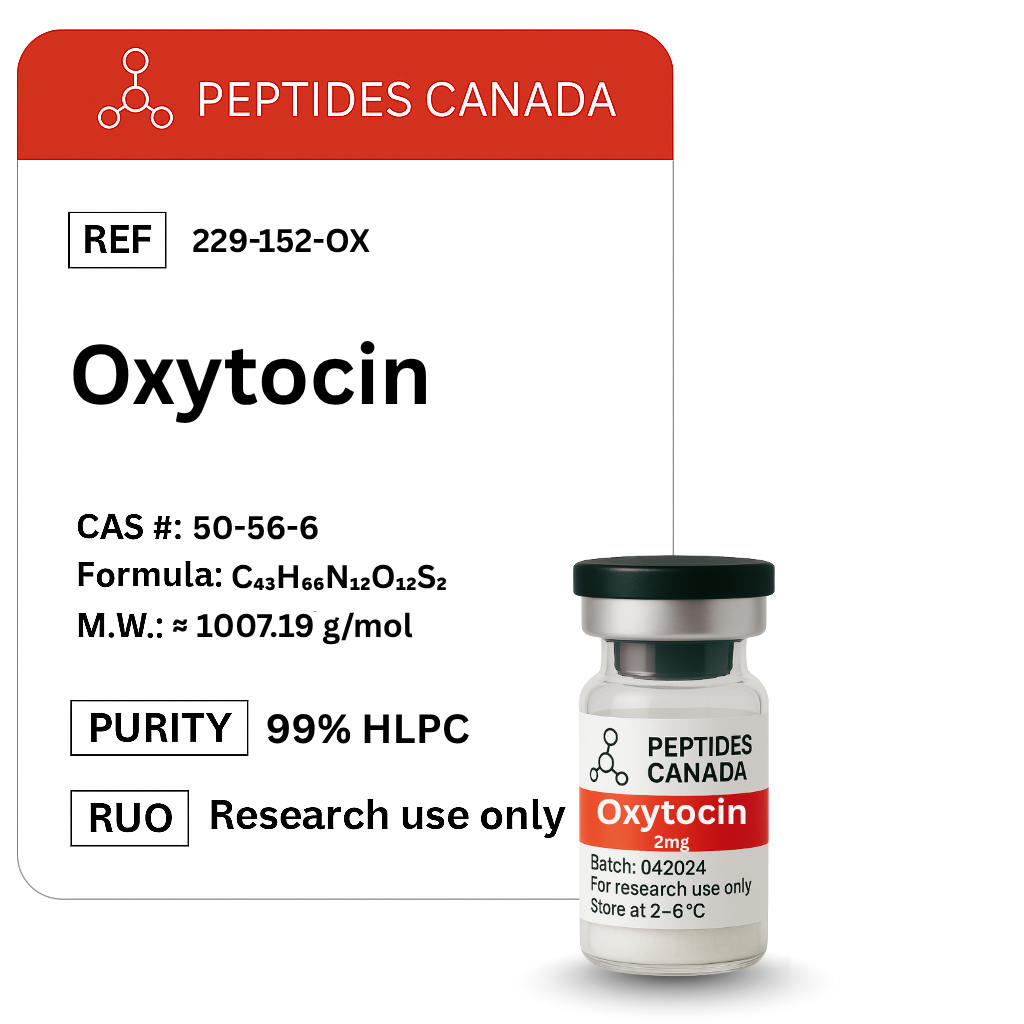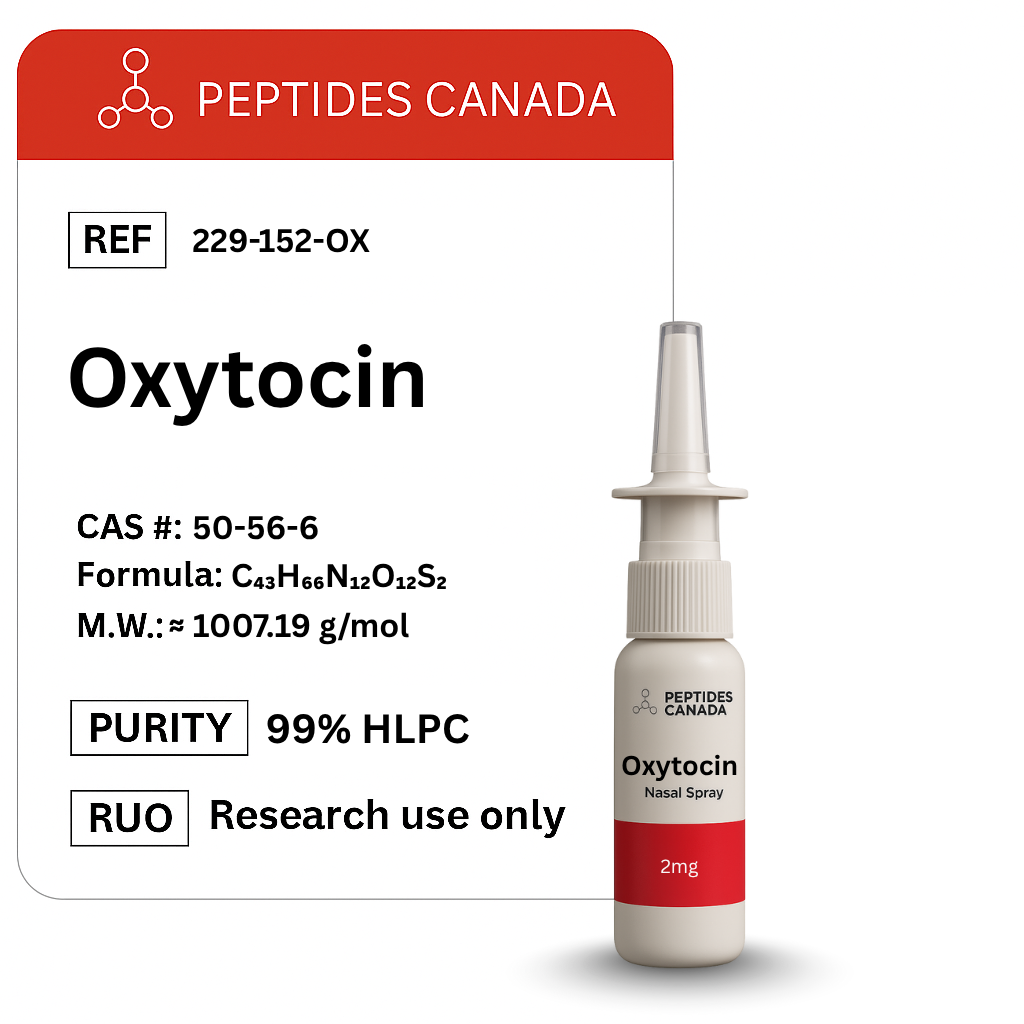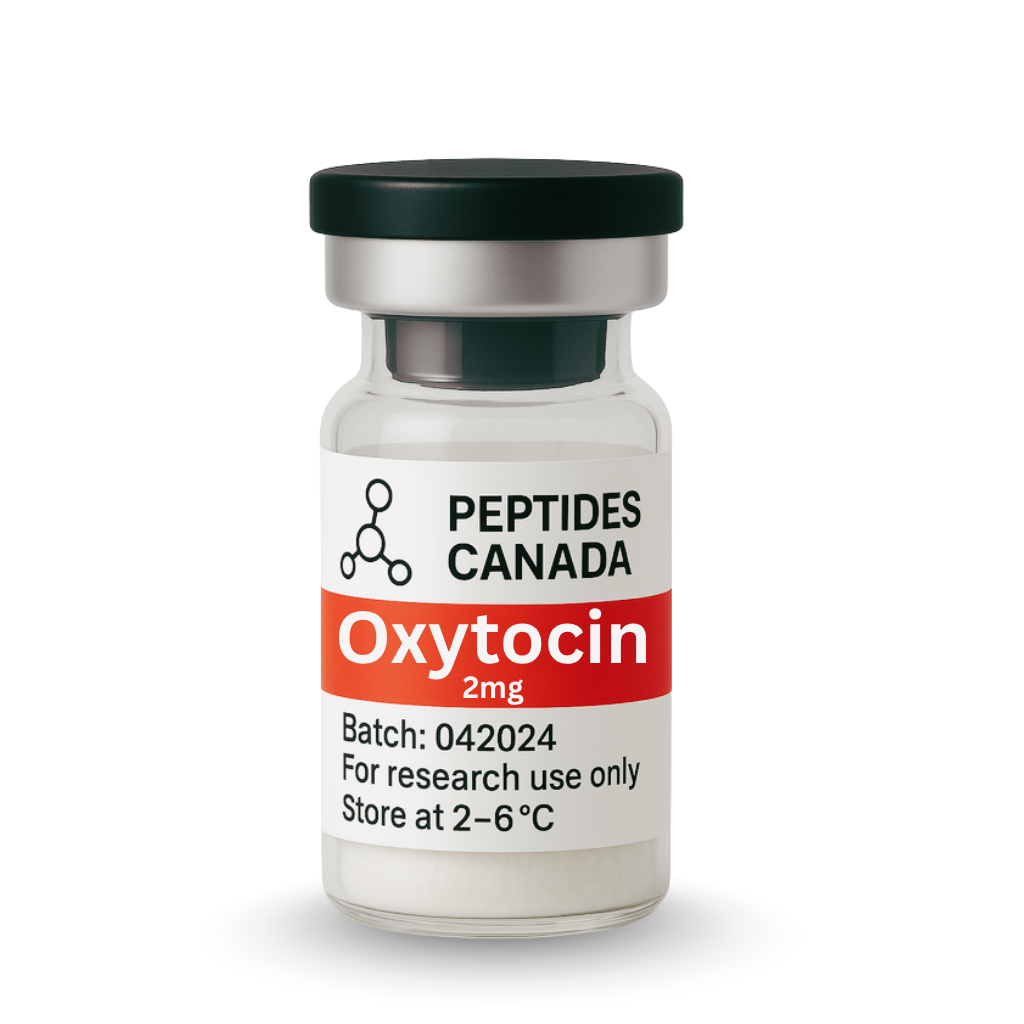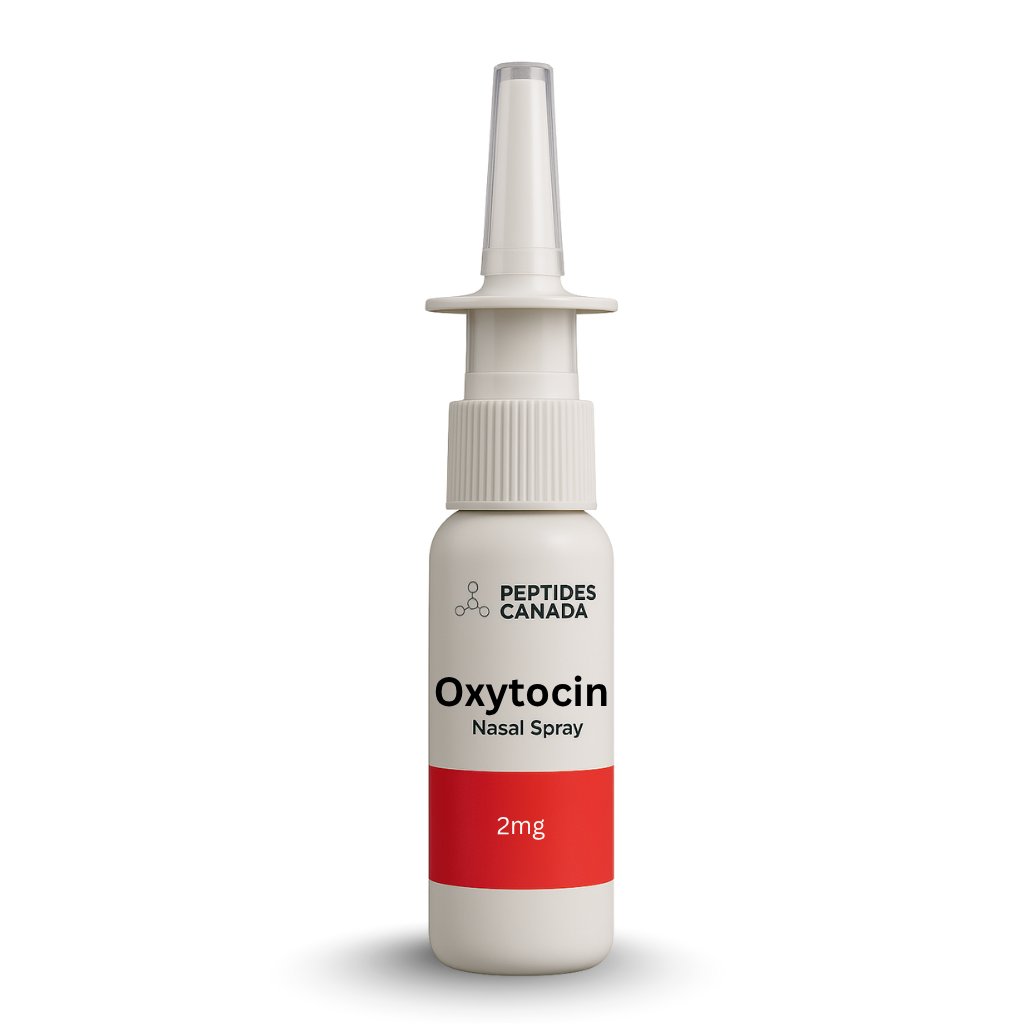Oxytocin
From CAD $40 CAD $50
Size: 2mg
Contents: Oxytocin (Neuropeptide Hormone)
Form: Powder
Purity: 99.3%
TESTED FOR:
- PURITY
- STERILITY
- WEIGHT
- ENDOTOXINS(LPS)
Free Reconstitution solution automatically added to your cart with each order of vial.
This product is Made, Tested & Shipped From Canada.
Ships Today
Order by 1:00 PM EST
Free Shipping
For 2 or more vials
99%+ Purity Guaranteed
COA Verified+
Trackable Shipping
Oxytocin Peptide
Oxytocin is a cyclic nonapeptide hormone synthesized in the hypothalamus and secreted by the posterior pituitary. It plays essential roles in reproductive physiology, social behavior, and stress regulation. In research settings, Oxytocin is used to study neuroendocrine signaling, emotional and social cognition, stress response, and parturition-related processes.
Overview
Oxytocin functions as both a peripheral hormone and a central neuromodulator. It binds to the oxytocin receptor (OXTR), a G-protein-coupled receptor (GPCR) widely expressed in the uterus, mammary glands, and specific regions of the brain.
Peripherally, Oxytocin mediates uterine smooth muscle contraction and milk ejection during lactation. Centrally, it influences social bonding, trust, and emotional behavior. Experimental models have demonstrated its role in anxiety modulation, pair bonding, and prosocial behaviors, as well as their interaction with dopaminergic and corticotropin-releasing hormone systems.
Chemical Makeup
- Molecular Formula: C43H66N12O12S2
- Molecular Weight: 1007.2 g/mol
- Amino Acid Sequence: Cys-Tyr-Ile-Gln-Asn-Cys-Pro-Leu-Gly-NH₂ (disulfide bridge between Cys¹ and Cys⁶)
- Compound Class: Nonapeptide hormone, neuropeptide
- Form: Lyophilized powder
- Purity: ≥99% (per COA)
- Sizes Available: 2mg, 5mg, 10mg vials
Research and Clinical Studies
Neuroendocrine Function
Oxytocin is a principal regulator of parturition and lactation, acting on uterine and mammary smooth muscle through Gq-mediated calcium signaling pathways. It is a critical neuropeptide for studying hormonal feedback and stress adaptation mechanisms.
Behavioral and Social Neuroscience
Oxytocin’s central release modulates social interaction, empathy, trust, and emotional processing. Research implicates the oxytocinergic system in attachment, parenting behavior, and neuropsychiatric disorders, including anxiety, autism spectrum disorder, and depression.
Cardiovascular and Metabolic Effects
Beyond its endocrine functions, Oxytocin has been shown to influence glucose metabolism, lipid mobilization, and vasodilation. Preclinical findings suggest a role in cardiometabolic regulation and tissue repair.
Stress and HPA Axis Regulation
Experimental studies indicate Oxytocin attenuates stress-induced activation of the hypothalamic–pituitary–adrenal (HPA) axis, decreasing cortisol secretion and promoting anxiolytic effects.
Pharmacokinetics
Oxytocin has a plasma half-life of approximately 3–5 minutes and is rapidly degraded by oxytocinase. It is commonly used in both central and peripheral research models to investigate receptor-mediated signaling and behavioral outcomes.
Oxytocin peptide is available for research and laboratory purposes only. Not for human consumption.
References
- du Vigneaud V, et al. The synthesis of an octapeptide amide with the hormonal activity of oxytocin. J Am Chem Soc. 1953;75(19):4879–4880. https://pubmed.ncbi.nlm.nih.gov/13099689/
- Gimpl G, Fahrenholz F. The oxytocin receptor system: structure, function, and regulation. Physiol Rev. 2001;81(2):629–683. https://pubmed.ncbi.nlm.nih.gov/11274341/
- Insel TR. The challenge of translation in social neuroscience: a review of oxytocin, vasopressin, and affiliative behavior. Neuron. 2010;65(6):768–779. https://pubmed.ncbi.nlm.nih.gov/20346754/
- Carter CS. Oxytocin pathways and the evolution of human behavior. Annu Rev Psychol. 2014;65:17–39. https://pubmed.ncbi.nlm.nih.gov/24050183/
- Heinrichs M, et al. Neuroendocrine mechanisms of stress and oxytocin. Biol Psychiatry. 2009;65(9):774–782. https://pubmed.ncbi.nlm.nih.gov/19091303/
- Neumann ID, et al. Central oxytocin mechanisms in stress and anxiety. Prog Brain Res. 2008;170:143–159. https://pubmed.ncbi.nlm.nih.gov/18655882/
- Lee HJ, et al. Oxytocin receptor signaling in social and emotional behavior. Prog Neurobiol. 2009;88(2):127–151. https://pubmed.ncbi.nlm.nih.gov/19482229/
- Leng G, Sabatier N. Measuring oxytocin and vasopressin: bioassays and immunoassays. J Neuroendocrinol. 2016;28(4). https://pubmed.ncbi.nlm.nih.gov/26768154/
- Meyer-Lindenberg A, et al. Oxytocin and human social behavior. Science. 2011;333(6039):1148–1151. https://pubmed.ncbi.nlm.nih.gov/21868668/
- Peters S, et al. Oxytocin and the stress response system. Front Neuroendocrinol. 2018;51:14–30. https://pubmed.ncbi.nlm.nih.gov/29414646/
HIGHEST QUALITY PEPTIDES
Our products are scientifically formulated and manufactured in cGMP-compliant facilities.
FAST DELIVERY
Enjoy fast and reliable 3–5 day shipping.
Dedicated Customer Service
Our customer service team is highly knowledgeable in peptide research and its applications. We’re available 24/7 to assist you.
Tested. Verified. Trusted.
We take a laboratory-first approach to quality. Each batch is made under controlled conditions and verified by an independent lab (HPLC/MS). We only ship batches that test ≥99% purity, and we provide a full COA, including identity, methods, and chromatograms, for your review.
See the Process for Yourself
We make our peptides in our own cGMP lab. Watch the video to see how every vial is produced, tested, and handled with care.
Science Behind Our Peptides
A clear explanation of how our peptides work, their benefits, why quality matters for best results, and what you should know.
Categories
Categories
How do I know the peptides I order are exactly what the label says?
Every vial we sell comes from a lab that follows current Good Manufacturing Practices (cGMP). That means each step of production is documented and controlled. Before a batch is released, it’s tested by independent third-party labs for purity, identity, and sterility. Certificates of analysis are available so you can see the exact test results.
Are your peptides produced in a sterile and controlled environment?
Yes. The labs we work with use ISO-certified clean rooms where air quality, equipment, and handling procedures are tightly regulated. Staff are trained to pharmaceutical-grade standards. This ensures the peptides are produced in an environment that minimizes contamination risks.
What about shipping? Do the peptides remain stable in transit?
Peptides in lyophilized (freeze-dried) form are stable at room temperature for transport. Once you receive them, refrigeration is recommended to maintain long-term integrity. We package every order securely to prevent damage and ship promptly, so your vials arrive in optimal condition.
How do I know you actually make these peptides yourselves?
We operate under strict in-house protocols that follow current Good Manufacturing Practices (cGMP). That means our team oversees the entire process from sourcing raw amino acids to the final lyophilized vial. Nothing is outsourced or repackaged. This gives us full control over purity, consistency, and sterility, and it’s why we can stand behind every single vial we ship.
What should I do with the vials once they arrive?
Store them in the refrigerator, away from direct light and heat. If you need to keep them longer, some peptides can be stored frozen. Each vial comes with clear handling instructions so you know the proper conditions for stability.
What proof do you have that your peptides are legitimate?
The strongest proof is transparency. For every peptide, we can provide certificates of analysis, manufacturing documentation, and references to the published scientific research behind it. If you ever have questions, we’ll show you the data rather than ask you to take our word for it.




